A Brand New Era
Lloyd Noble didn't hesitate when he sought a solution to revitalize agriculture in southern Oklahoma following the Dust Bowl. Seven decades later, his legacy continues with another bold step for his organization.
Four hundred sets of eyes focused on Steve Rhines in anticipation of further explanation.
The dawning of a new era in an organization’s history is a momentous occasion, and, at this particular occasion, the 400 employees were devouring every detail. This highly anticipated all employee meeting, held April 26, 2017, promised to reveal a plan they knew had been months in the making.
Minutes earlier, Bill Buckner, president and CEO, and Rusty Noble, a grandson of the organization’s founder, Lloyd Noble, had announced to employees that the Noble Foundation would become the Noble Research Institute in five days.
The Noble Research Institute would be an agricultural research organization. Not in just the descriptive sense of the phrase, as had been true for the past seven decades. But in the legal sense. A new classification of nonprofit, an “agricultural research organization” or ARO for short, had been created by Congress in 2015, and Noble was pursuing the designation.
The first step – which would be taken on May 1, 2017 – was to split the original Noble Foundation into two entities: one for research and education, one for philanthropy.
For Rhines, this moment was important. The vice president and general counsel took the stage and invited his fellow employees into his world of tax code and legal technicalities, into the land of tax-exempt rules that shape what these plant scientists and agricultural consultants can do and how they can do it. As part of a private foundation – the organization’s current, tax-exempt status – its research and educational operations were operating as square pegs in a round hole. The transition would round out the pegs.
In short, all of the Noble Research Institute’s operations – education, producer relations, research and demonstration – would continue. At the same time, this pursuit to become an ARO ushered in a brand new era for the organization and agriculture.
By the end of his presentation, Rhines jokingly told the audience they each now had a “minor in tax code.”
More laughter rippled through the crowd as he summed up the logistical part of the transition: “On Monday, we’ll all come to work as Noble Foundation employees. At about 10 a.m., we will all simply become Noble Research Institute employees.”
These researchers were about to be given new tools for moving their science, knowledge, and innovative ideas into the hands of farmers, ranchers, and other land managers. Creating the new tools for these tool-builders of agriculture was a 25-year-long organizational marathon – one that Rhines became a part of upon his arrival in 2001 – that wasn’t quite finished.
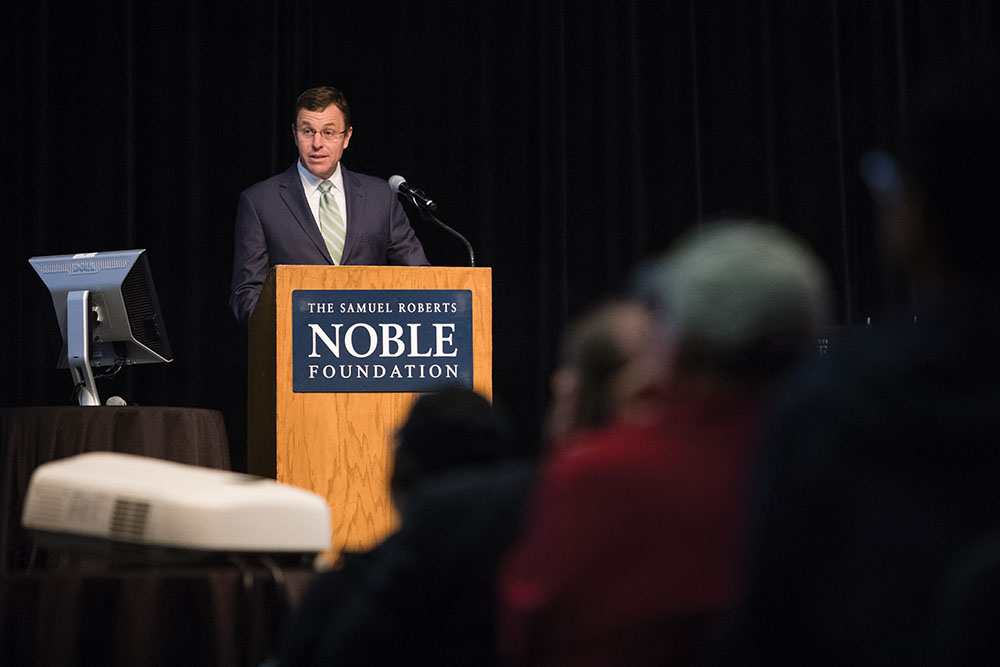
What Is An ARO?
Agricultural research organizations are a type of 501(c)(3) public charity. An ARO is required to:
Directly engage in the continuous active conduct of agricultural research.
Conduct research in conjunction with a land-grant college or university or a non-land-grant college of agriculture.
Either devote a substantial part of its assets to or expend a significant percentage of its endowment (3.5 percent or more of the fair market value of its endowment) or both for the continuous active conduct of such agricultural research.
For More Information
A Different Breed
Those curious about anything ARO-related will find their answers in the bottom drawer of Rhines’ office credenza.
This drawer represents an intense journey that spans eight-plus years of Rhines’ career and holds historical files that date back to the early 1990s, the genesis of the idea. It includes letters and documents all neatly arranged in manila folders and expandable files.
When Rhines came to the Noble Foundation in 2001 to serve as intellectual property counsel, he became part of a project that had started in 1992 with a simple question: How do we best steward the resources provided by Lloyd Noble when he established this organization so they can benefit agricultural producers and consumers in this generation and those to come?
The Internal Revenue Code, or Code, defines two types of 501(c)(3) nonprofits: public charities and private foundations. Since its inception, the Noble Foundation had been regarded as a private foundation; however, the scale of its operations made it a unique one.
Like most private foundations, the Noble Foundation was initially funded by one private source (Lloyd Noble) and most of its revenue came from the investment of those funds. Most private foundations provide grants to other charitable organizations that conduct research, provide services or administer other operations to directly benefit people; the Noble Foundation provided such grants.
Unlike most private foundations, the Noble Foundation also conducted its own direct operations: basic and translational plant science, applied agricultural research and demonstration on working farms and ranches, no-cost consultation for farmers and ranchers, and educational programs for youth and adults.
In many ways, the Noble Foundation’s research and education operations were akin to the operations found in universities and peer research institutes, all of which are public charities.
But the Noble Foundation was not a public charity per the definitions found within the Code. As a private foundation, the Noble Foundation was at a disadvantage in regards to how it funded its research from third-party donors, how it could partner with others to develop technology and innovations, and its options for moving technology and innovation from its fields and laboratories into the hands of farmers and ranchers, who are striving to feed a growing world population and conserve natural resources.
While the benefits of being a public charity over a private foundation are commonly appreciated, the Noble Foundation had no viable way to become one. The Noble Foundation didn’t fit any of the specific public charity molds. It wasn’t a church or a hospital or an educational institution. And its revenue came primarily from one source: a family’s endowment, as opposed to a broad base of public support, including governmental research grants and private donors. Further, with there being a finite amount of such public support for nonprofit agricultural research – particularly for research that does not directly influence or affect commodity crops – the Noble Foundation did not have many options.
In 2004, Rhines and others from the Noble Foundation met with counsel in Washington, D.C., to discover whether an obvious alternative had been overlooked in its quest to become a public charity. In these conversations, attorneys from the firm of Hogan & Hartson (today, Hogan Lovells) saw parallels between the Noble Foundation’s structure and operations and another type of tax-exempt organization: medical research organizations (MROs). The distinction, of course, was that these organizations are dedicated to the conduct of human medical research, which did not extend to matters of soil, plants, water or animals.
Hogan’s connection to medical research organizations was not obvious but significant. The firm had worked with representatives of Howard Hughes in the 1950s to modify the Code to define and create MROs as a recognized type of 501(c)(3). The Howard Hughes Medical Institute ultimately became the first MRO in the U.S.
Having a clear understanding of the challenges, the firm said finding public charity status through MROs or an MRO-like model would be difficult for the Noble Foundation. They offered the sobering counsel that at a minimum the definition of “medical research” would need to be modified to encompass agricultural research or, more preferably, a new “agricultural research organization” would need to be created within the Code. Their consensus was that potential for modifying the Code to create a new type of 501(c)(3) was ill-timed and not likely achievable.
Much like times before, the Noble Foundation’s options to become a public charity appeared unachievable if the foundation continued its agricultural research and educational programs in furtherance of its organizational mission. Importantly, however, the Board of Directors, which is largely composed of Lloyd Noble’s descendants, was not willing to compromise the organization’s activities, impact and purpose merely to achieve a particular tax-exempt form.
The written form of Hogan’s guidance was filed away with similar opinions and other concepts that had accumulated from external counsel over the years of exploration.
There, the documents sat for three years. But the MRO seed had been planted.
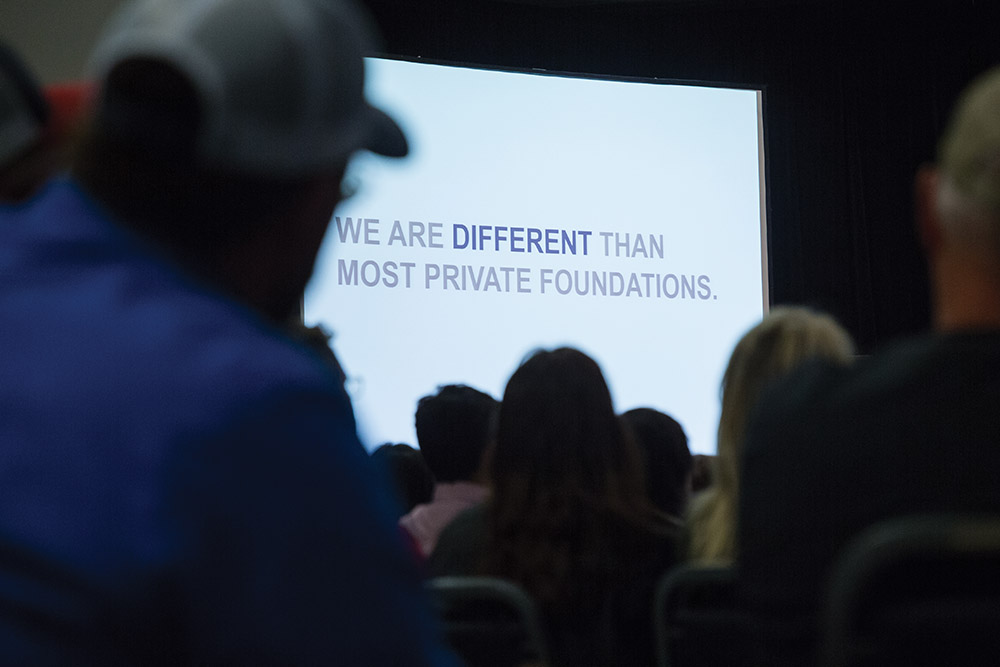
A Bold Step
In 2008, the discussion of potential tax-exempt options surfaced once again. Rhines dug into his file drawer and reviewed the many routes that had been considered, including the Hogan comments. The MRO concept – even with its obstacles – resonated the loudest.
MROs were a proven model for philanthropists, offering an additional avenue to give. Beyond donating to existing organizations or establishing private foundations to make grants to others, MROs allowed philanthropists to directly fund and conduct medical research.
MROs are a unique form of public charity in that their primary source of revenue is from a single source, similar to a private foundation like the Noble Foundation. To satisfy their obligation to serve the public (and to maintain their tax-exempt status), Congress required that MROs 1) engage in the continuous conduct of medical research, 2) conduct research in conjunction with at least one nonprofit or government hospital, and 3) spend at least 3.5 percent of the fair market value of their endowment in conducting such research.
There are more than 200 MROs operating in the U.S. today. Many of these organizations have storied histories and visionary founders that, similar to Lloyd Noble, had a desire to better human health through the conduct of research; philanthropists like Paul Allen, the late Jim Stowers, and the Van Andel family.
The second review of the MRO concept reaffirmed that an MRO model did not specifically offer the Noble Foundation an avenue to becoming a public charity, but it did offer a usable model. An idea was born, one that could establish independent research institutions with the focus of conducting research on areas (i.e., water, soil, plants and animals) that directly influence food safety and supply, fiber production, the environment, and society.
Rhines drafted the initial legislative language that would create agricultural research organizations, or AROs, and internal discussions and vetting began.
By June 2008, Michael Cawley, Noble Foundation president at the time, along with Rhines and Jeff Moen, who joined the organization in 2007, developed a proposal and presentation for the Board to consider pursuing the idea of AROs.
If AROs became a reality, it would be a perfect fit for the Noble Foundation. No longer would the organization not quite fit as a private foundation and not quite fit as a then-known public charity.
Even greater, the concept could help solve a much larger issue facing the agriculture sector: lack of funds available for research. Creating AROs would open new opportunities for more people to dedicate their wealth to agricultural research. (See the next story about the potential impact of AROs on agricultural research).
It would be a bold step. There were many unknowns. They just needed one last, crucial answer and the Board provided it: “Yes.”
Rhines and Moen spent the equivalent of several months on the road over the next eight years traveling the country, explaining the concept, receiving input to improve the legislative proposal, and educating other agricultural organizations. They visited with deans of agricultural colleges, industry leaders, and, ultimately, lawmakers and their staffs.
The project was forecast to require two years, but the project timetable was influenced by changing administrations, ever-present discussions of tax reform and evolving political environments.
With the assistance of legislative advisers in Washington, D.C., Rhines and Moen connected with House and Senate offices that understood agriculture and the impact research has on both the present and the future. They understood the challenges of continuing to fund agricultural research primarily from appropriated public dollars, and they too sought a greater complementary role from private philanthropy to advance agriculture.
The legislation was championed and led by a geographically diverse group of legislators from California (Chairman Devin Nunes), Wisconsin (Rep. Ron Kind), South Dakota (Sen. John Thune) and Michigan (Chairwoman Debbie Stabenow). Closer to home, many of Oklahoma’s legislative representatives, including Sen. Jim Inhofe, Rep. Tom Cole and Rep. Frank Lucas, provided key insight and guidance throughout the legislative effort.
By 2015, there were 65 associations, universities and other nonprofits lending their support to what had become known as the Charitable Agricultural Research Act, which had bipartisan support in both the U.S. House of Representatives and U.S. Senate. The bill was introduced eight times from 2011 to 2015 before it was signed into law by former President Barack Obama on Dec. 18, 2015, as part of the Protecting Americans from Tax Hikes Act of 2015.
“There were many times when it seemed this wasn’t going to work, when our plans would get derailed by a multitude of things that had nothing to do with the merits of the legislation,” said Rhines more than a year after the Act passed, “but we kept going back to something one of the Board members, Bill Goddard, said in one of our early meetings: ‘AROs extend the legacy of Lloyd Noble; this effort serves a greater purpose.’ Being a part of something like that doesn’t happen every day or even in every career.”
The Board closely followed the progress of the legislation, so there was no surprise to them when it was signed into law. After 70 years of operating the organization as a private foundation, though, there was still much to discuss and consider before deciding to transition the Noble Foundation into an ARO.
One of these considerations was the Noble Foundation’s grant-making program.
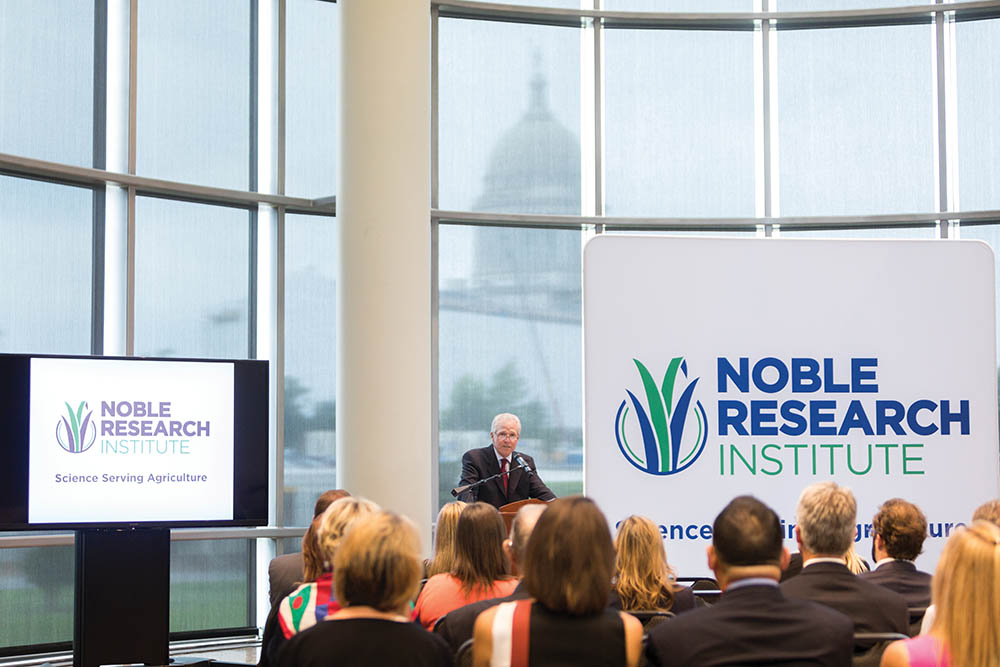
Continuing The Legacy
The Noble Foundation made its first grant – $14,000 for an electron microscope – to the University of Oklahoma in 1946. By April 2017, the organization had provided more than $328 million in scholarships and grants to other nonprofits. These nonprofits included local arts and youth programs, hospitals and medical research institutes, and other community-supporting organizations, primarily in Oklahoma.
The ARO model was an ideal match for the Noble Foundation’s direct operations because: 1) AROs must continuously and directly conduct agricultural research. About one in four Noble employee has a Ph.D., and nearly every employee is either directly involved in research or supports those who are. 2) AROs must conduct research with at least one land-grant university or non-land-grant college of agriculture. The Noble Foundation has worked with qualifying universities or colleges since at least 1950, and today Noble researchers and consultants work in conjunction with more than 10 qualifying universities or colleges with additional collaborations pending. 3) An ARO must spend more than 3.5 percent of the fair market value of its endowment for research. The Noble Foundation has often exceeded 5 percent (the amount required of a private foundation) of the fair market value of its endowment for its operations.
But the Noble Foundation’s grant-making program, as it existed, could not function within the ARO requirements. The Board members discussed this dilemma at great length. They didn’t want to end their giving and its impact on charitable organizations and communities.
So, they decided to separate the activities of the Noble Foundation. The research, education, consultation and on-farm activities would carry forth in the existing entity, which would transition from a private foundation to an ARO. The philanthropic activities, including the grant-making and scholarship programs, would continue in a new private foundation.
This left the new organization to be named.
The Board decided the new private foundation should use the original name: Noble Foundation. They felt this best reflected the original legacy attached to the name, which was chosen by Lloyd Noble to honor his father, Samuel Roberts Noble, as the most charitable man he knew.
The original organization, which would become an ARO, would receive a new name: the Noble Research Institute, LLC. The new Noble Foundation would act as the Noble Research Institute’s parent, meaning the same governing board that made these decisions would continue to govern the organization through the Noble Foundation.
In December 2016, the Board members took a final vote. It was unanimous. The plan would move forward.
For Rhines and Moen, who had started this journey so many years before, it was an endpoint and a beginning. They had served to move an unlikely concept into reality, which could conceivably benefit all of agriculture. More personally, however, they had helped build an opportunity that had immediate and tangible impact on the Noble Foundation and its long-standing operations.
The satisfaction of completing the milestone, however, was temporary. With this historic vote, much work lay ahead. The plan was to separate the organization on May 1, a mere four months away.
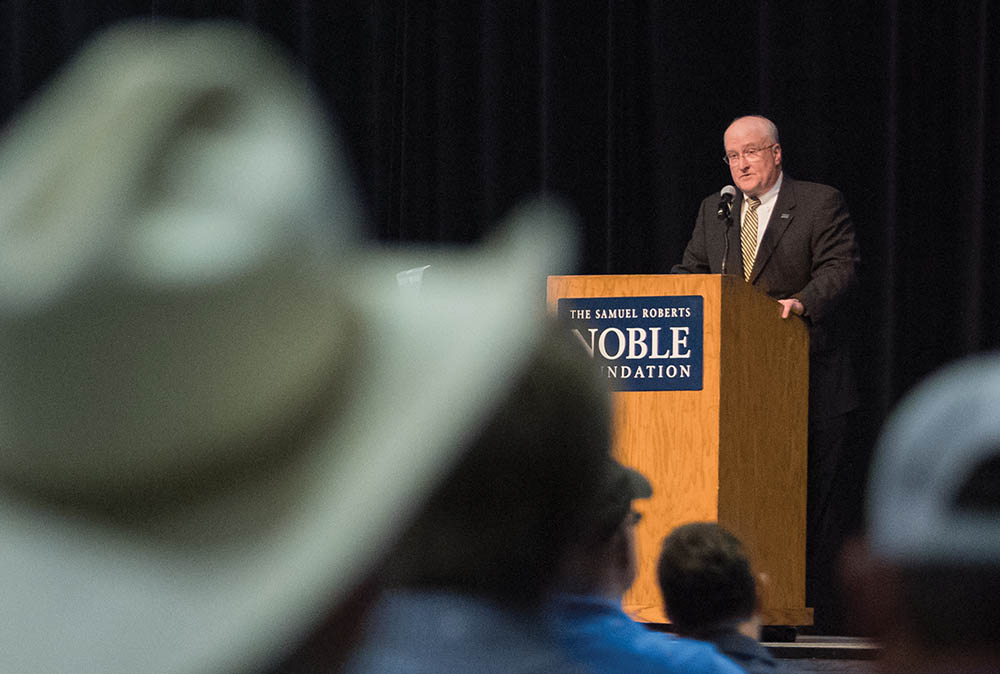
New Tools For Agriculture
The most important aspect of the action plan was to bring the employees into it.
It was no secret that the Noble Foundation was involved in creating the ARO designation. However, details affecting the organization weren’t discussed until after the Board had made its final decision. It was important to the Board, however, that the employees be brought up to speed before the papers were filed and the public aspects of the process officially began.
Will Moseley, a wildlife and fisheries consultant, describes the weeks leading up to the announcement as filled with wonderings about what was to come. By this time, employees had known for months that the Board had officially decided to pursue turning the Noble Foundation into an ARO.
“We knew it was coming, but we didn’t know how or what it would look like,” Moseley said. “When the announcement was made, I thought the direction made sense. I was impressed with how well thought out everything was, and I was excited about how the organization was going to be able to move forward.”
President Bill Buckner and other members of the leadership team, including Rhines, spent the three-hour meeting outlining the transition. Excitement began to build, especially when the microphones were turned off and the meeting room turned into a party room. Long lines formed at food stations and tables, where everyone could pick up a bag filled with goodies, including a T-shirt featuring the new Noble Research Institute logo.
The next step was for Rhines to submit the paperwork to effect the final name changes and to notify the IRS of the organization’s decision to transition from a private foundation to a public charity for the Noble Foundation. That was May 1, 2017.
Then, the announcement was ready to go public.
On May 10, familiar faces from the Ardmore community trickled into the Ardmore Convention Center, where they learned the news. This time, Jessie Nance, a Board member and great-granddaughter of Lloyd Noble, joined Buckner on stage to reveal the Noble Research Institute’s new logo.
Gary Simmons, who retired from the Noble Foundation in 1988 as the Agricultural Division director, held up his cellphone to take photos of Buckner’s presentation of the Noble Research Institute’s new mission statement: “To deliver solutions to great agricultural challenges.”
“Having been part of and accustomed to Noble Foundation name for some 62-plus years, I wondered why the change,” Simmons said. “However, I see that the change should open up more opportunities to increase the various services of the Noble Research Institute. The forward thinkers within the organization who suggested and investigated the advantages of the change are to be commended.”
He added: “Plus, coffee tastes the same in the Noble Research Institute cup as it did in the Noble Foundation cup.”
After inviting the community to take home Noble Research Institute gift bags, the Noble crew packed up and headed to Oklahoma City for the state announcement, where Lt. Gov. Todd Lamb joined in the celebration.
Over the next several days, as everyone learned to say “Noble Research Institute” rather than “Noble Foundation,” the flurry of activity continued. Websites needed updating. Everything from letterhead to light pole banners needed the new logo. The transition was taking shape.
But for the general activities, business continued as usual. Or, as Nikki Charlton, Ph.D., a senior research associate in the mycology laboratory, said, “It’s research as usual.”
Moseley echoed the thought. “There wasn’t a lot of change to the activities that support our purpose and the mission of the organization. We’re still helping farmers and ranchers like we’ve always done. We just have a few new opportunities now,” he said. “This opens a lot of doors to fill niches in agriculture that aren’t being filled right now. And while we won’t go jumping into those immediately, it’s exciting that the possibilities are on the horizon.”
For Rhines, the marathon isn’t quite over. He anticipates months to go by before receiving notification from the IRS that they officially recognize the Noble Research Institute as a public charity, more specifically as an ARO. Then, a standard 60-month process will begin to terminate the organization’s status as a private foundation. During this time frame, the Noble Research Institute will begin to report its ongoing activities that support the agricultural research organization.
And when the Noble Research Institute does officially become an ARO, it will be far from an end. A new lap in the marathon of continuing Lloyd Noble’s legacy will have begun.
“The product of this effort will give our organization a great set of new tools,” Rhines said. “I’m excited to see how these come together to add to our history of benefiting agriculture.”
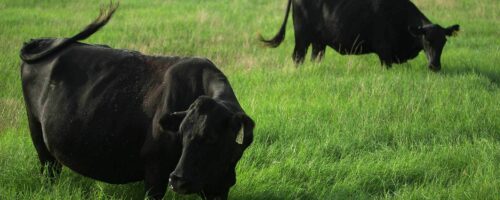
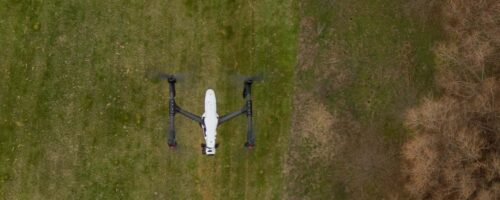
Comment